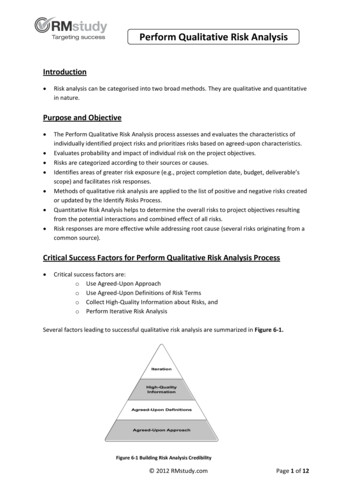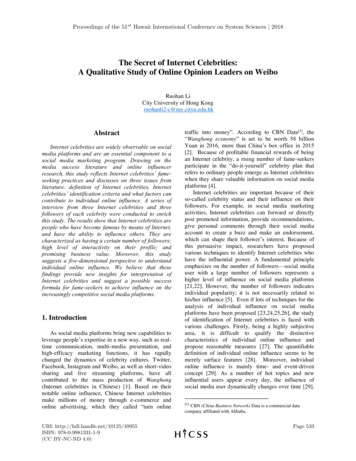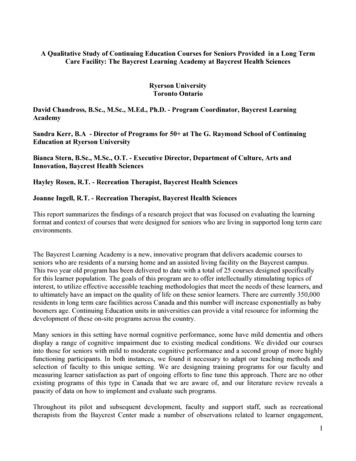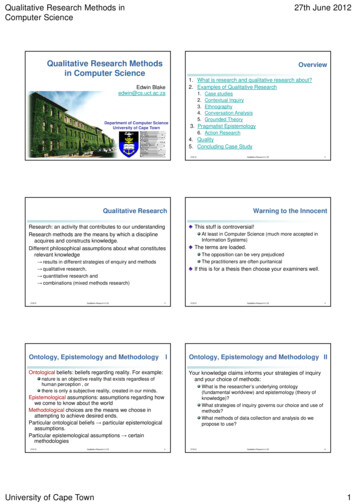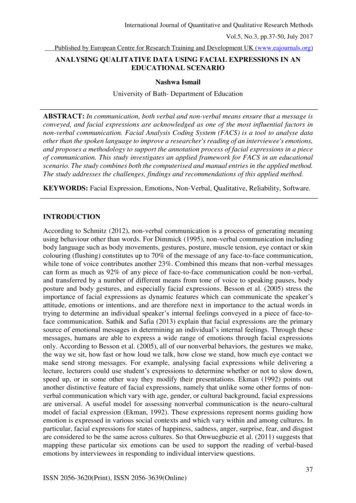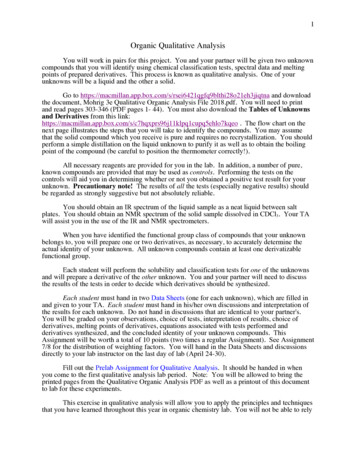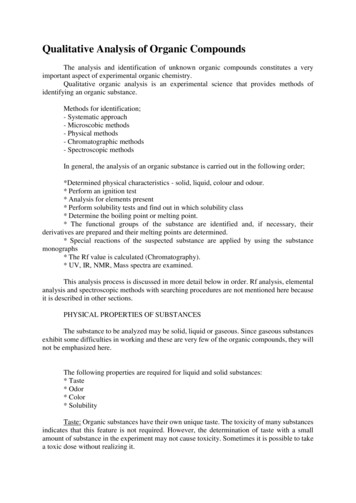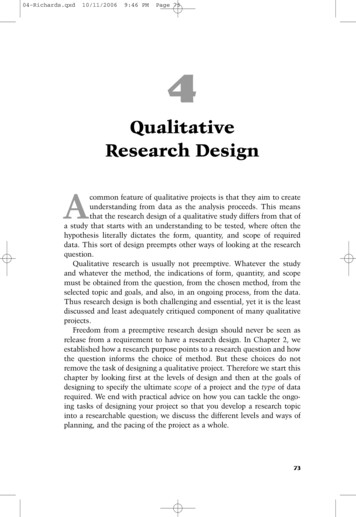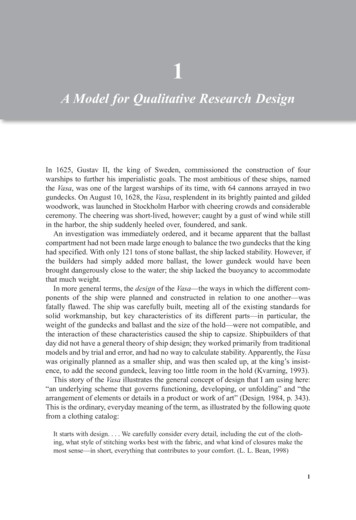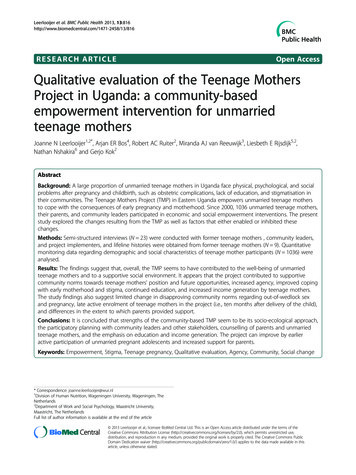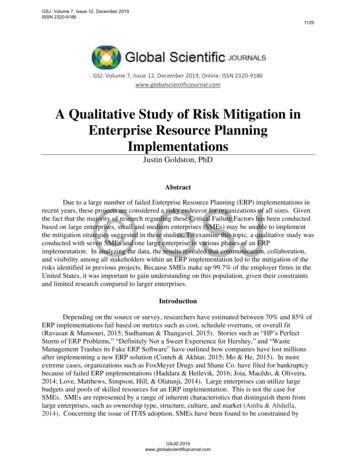
Transcription
GSJ: Volume 7, Issue 12, December 2019ISSN 2320-91861129GSJ: Volume 7, Issue 12, December 2019, Online: ISSN 2320-9186www.globalscientificjournal.comA Qualitative Study of Risk Mitigation inEnterprise Resource PlanningImplementationsJustin Goldston, PhDAbstractDue to a large number of failed Enterprise Resource Planning (ERP) implementations inrecent years, these projects are considered a risky endeavor for organizations of all sizes. Giventhe fact that the majority of research regarding these Critical Failure Factors has been conductedbased on large enterprises, small and medium enterprises (SMEs) may be unable to implementthe mitigation strategies suggested in these studies. To examine this topic, a qualitative study wasconducted with seven SMEs and one large enterprise in various phases of an ERPimplementation. In analyzing the data, the results revealed that communication, collaboration,and visibility among all stakeholders within an ERP implementation led to the mitigation of therisks identified in previous projects. Because SMEs make up 99.7% of the employer firms in theUnited States, it was important to gain understanding on this population, given their constraintsand limited research compared to larger enterprises.IntroductionDepending on the source or survey, researchers have estimated between 70% and 85% ofERP implementations fail based on metrics such as cost, schedule overruns, or overall fit(Ravasan & Mansouri, 2015; Sudhaman & Thangavel, 2015). Stories such as ―HP‘s PerfectStorm of ERP Problems,‖ ―Definitely Not a Sweet Experience for Hershey,‖ and ―WasteManagement Trashes its Fake ERP Software‖ have outlined how companies have lost millionsafter implementing a new ERP solution (Conteh & Akhtar, 2015; Mo & He, 2015). In moreextreme cases, organizations such as FoxMeyer Drugs and Shane Co. have filed for bankruptcybecause of failed ERP implementations (Haddara & Hetlevik, 2016; Joia, Macêdo, & Oliveira,2014; Love, Matthews, Simpson, Hill, & Olatunji, 2014). Large enterprises can utilize largebudgets and pools of skilled resources for an ERP implementation. This is not the case forSMEs. SMEs are represented by a range of inherent characteristics that distinguish them fromlarge enterprises, such as ownership type, structure, culture, and market (Amba & Abdulla,2014). Concerning the issue of IT/IS adoption, SMEs have been found to be constrained byGSJ 2019www.globalscientificjournal.com
GSJ: Volume 7, Issue 12, December 2019ISSN 2320-91861130limited resources, limited IS knowledge, and lack of IT expertise (Bansal & Agarwal, 2015).Major projects face increased external and internal risks when compared to large organizations.Externally, SMEs are more fragile than large companies and face greater difficulty in obtainingcredit (Zach & Munkvold, 2012). Such external risks could lead SMEs to delay the project ofERP implementation or forego it altogether. Internally, SMEs may find it difficult to implementre-engineering projects due to limited resources. Overall, SMEs may face greater challenges inadopting technology as compared to large enterprises given the constraints mentioned above(Zach & Munkvold, 2012).Chen and Dwivedi (2007) note that company size is significant in comparing ERPimplementations of large enterprises and SMEs. The authors go on to explain that a companywith 20 employees and a company with 500 employees have different ways of managing theirinformation systems (Chen & Dwivedi, 2007). There are more barriers to an ERPimplementation for SMEs than there are for large businesses due to the high capital investmentand skilled manpower involved in implementing and operating an ERP solution (Chen &Dwivedi, 2007). Research has shown that some issues are proved to be crucial for smallcompanies but not for large enterprises, such as proper system implementation strategy, clearlydefined scope of implementation procedure, proper project planning, and minimal customizationof the system selected for implementation (Zach & Munkvold, 2012). In addition to the budgetconstraint, varying issues have been documented in the case studies of large-scale and SMEdeployments. Appendix A outlines the top-ten failure factors for ERP implementations for largeenterprises and SMEs respectively.Even though ERP systems were initially developed to run large scale enterprises, SMEsare increasingly motivated to introduce ERP implementations (Upadhyay, Basu, Adhikary, &Dan, 2010). In an SME environment, once approved, a full annual IT budget could be spent onERP implementation efforts. A survey of manufacturing firms revealed that the ERP investmenttends to be relatively heavier for small companies (Upadhyay, Basu, Adhikary, & Dan, 2010). Inone study, researchers found that ERP implementation costs, as a percent of revenue, range from0.82% for large firms to 13.65% for SME firms. One reason for this range in costs as a percentof revenue could be that there are economies of scale working for the larger firms (Bohórquez &Esteves, 2008). In addition to original software and consulting costs, poorly implemented andmanaged solutions result in a 2% increase in operating costs and administrative costs and add atleast one more full-time employee. Given the ―hidden costs‖ of ERP implementations, SMEsmust have an understanding of the Total Cost of Ownership of an ERP application beforeembarking on a project of this magnitude. Figure 1 compares large enterprises and SMEsregarding organization size and initial contracted implementation budgets as compared to theorganization‘s annual revenue. In analyzing the chart, it can be seen that SMEs have anincreased probability of a failed implementation based on the implementation budget andresource availability metrics.GSJ 2019www.globalscientificjournal.com
GSJ: Volume 7, Issue 12, December 2019ISSN nagementFoxMeyerDrugsSME ASME BSME CSME D1131 12B*Implementation Percentage ofBudgetAnnual Revenue 250M*2.083%Number ofEmployees34,759** 24.1B* 13.6B* 400M* 100M*1.660%0.735%44,000**44,300** 5B** 100M**2.000%2,700** 100M*** 36.3M*** 95M*** 30.9M*** 1.6M*** 671,985*** 432,690*** 98***Figure 1: Comparison of Large Enterprise versus SME implementation budgetsSources*- Krigsman, Michael. 2013**- Waligum, Thomas. 2009***- Big Three ERP Firm. 2014In studies conducted in large enterprise environments, successfully implemented ERPapplications allow an organization to gain a competitive advantage by saving resources and byresponding to the ever-changing business environment (Mahdavian, Wingreen, & Ghlichlee,2016; Sudhaman & Thangavel, 2015). Additionally, a successfully deployed ERP system canincrease customer satisfaction, reduce inefficient spending, strengthen sales and forecasts, reduceinventory turn-around times, and enhance employee productivity (Maas, Fenema, & Soeters,2014). Because large enterprises have been implementing ERP solutions since the mid-90s,SMEs view an ERP solution as the magic bullet to set them apart from the competition – but thisbelief is due to their lack of experience and knowledge of ERP implementations. In a recentsurvey of 122 SMEs, it was discovered that only 32 percent of those that implemented an ERPsolution recouped their investment in their ERP application (Krigsman, 2013). In the samesurvey, the respondents go on to say the main factors were attributed to cost and timelineoverruns (Krigsman, 2013). From this survey, it can be seen that failed and improperly plannedERP implementations can have lasting effects on SMEs.GSJ 2019www.globalscientificjournal.com
GSJ: Volume 7, Issue 12, December 2019ISSN 2320-91861132Figure 2: Timeline to Recoup Costs (Source: Panorama Consulting)According to Huin (2004), unless the differences between SMEs and large enterprises areclearly conceived, the ERP project continue to be ―slow, painful, and at times even unfruitful‖(p. 516). In researching large enterprises and SMEs, Ondrej and Munkvold (2011) discoveredthat large enterprises have more successful implementations than SMEs because of ownershiptype and organizational maturity level. Based on the research of SME ERP implementations, aswell as the empirical evidence in various ERP implementation environments, various factors thatled to failed ERP implementations in large enterprise and SME environments have beenuncovered. In this study, the Critical Failure Factors of SMEs compared to large enterprises andwill conclude with how SMEs can mitigate these potential risks throughout the implementationlife cycle will be analyzed.The ERP Life CycleSeveral ERP life cycle models have been reported in the literature to emphasize criticalphases and related activities during an ERP project. These models have phases comprisingprocesses of pre-implementation, implementation, and post-implementation (Hustad & Olsen,2013). From Figure 3, it can be seen that even though organizations follow different standardsthroughout the ERP Life Cycle, the phases in each standard are somewhat similar in nature. Toexpand further on these methodologies, Markus and Tanis (2000) developed an implementationproject methodology entitled the ―Enterprise System Experience Cycle.‖ This methodologyconsists of four phases: 1) The Project Chartering Phase is comprised of executive buy-in andacceptance, preliminary budget decisions, definitions of business case, and solution constraints;2) The Build Phase involves the configuration of the system, developing a detailed project plan,GSJ 2019www.globalscientificjournal.com
GSJ: Volume 7, Issue 12, December 2019ISSN 2320-91861133preparing the end users for the new system, and getting the end users up and running; 3) TheShakedown Phase is critical and involves stabilizing the system, eliminating bugs, and gettingthe company back to normal operations as quickly as possible; and 4) The Onward andUpward Phase, which comprises maintenance of the system, supporting the users, gettingresults, and upgrading decisions. In the subsequent sections, each phase will be described inmore detail.Figure 3: Project Methodologies (Source: Jiang, J.J.; Klein, G. 1999)2.1 The Solution Discovery backgroundIn the empirical research, most SMEs look at their business application from a tacticalperspective and selected a limited solution or a pre-configured plug-and-play solution. Thisdecision causes an organization to build their business process around the application, resultingin many workarounds and processes that need to be performed manually outside of the system.Additionally, as these companies grow over the years, they tend to find themselves with manydisparate applications with less than desirable data. When companies realize they have outgrowntheir current application, they tend to migrate toward the idea of implementing an ERP solution.In a recent study, 68% of SME managers are aware that their success and growth are dependenton a powerful IT solution. Furthermore, 72% believe that flexibility during growth is reliant onthe IT landscape (Hustad & Olsen, 2013). In comparison to large enterprises, large organizationscan review white papers and publications outlining successful implementations of the large ERPvendors to establish a list of potential partners to review their solutions. Though metrics such asGSJ 2019www.globalscientificjournal.com
GSJ: Volume 7, Issue 12, December 2019ISSN 2320-91861134flexibility and vendor support are vital to both large enterprises and SMEs, Appendix B outlinesthe differences in decision-making criteria between these two groups.2.2 The Planning Phase backgroundAfter the contracts have been signed, and the project has been scoped, the planning phasebegins. Though the initial timeline for the organization has been scoped, only when thecompany initiates the Project Kickoff engagement with their new partner will they realize theactual project timeline. During an interview, an ERP consultant stated that in his years ofexperience in engaging in project kickoffs, over 80% of customers have unrealistic deadlines. Ina study regarding Critical Failure Factors in Information Systems (IS) projects, one organizationstated that the main failure factor of their implementation was due to the underestimation of theproject timeline (Momoh, Roy, & Shehab, 2010). Given the fact that the ERP provider performsthese types of implementations on a normal basis, the organization could look to this new partneras a liaison to assist them in planning the implementation.2.3 The Execution Phase backgroundBased on the premise that the Implementation Execution Phase is the most critical phaseof the ERP life cycle, as depicted in Figure 4, the majority of resources, time, and capital will beconsumed during this phase. Because of the number of activities performed during this phase,SMEs and large enterprises may break this phase up into sub-phases. In most implementations,the Steering Committee formed during the Solution Discovery phase will be a part of theimplementation throughout the life of the project. Though the implementation will consume asignificant amount of their time throughout all sub-phases of the Implementation ExecutionPhase, almost all employees within an SME will be a part of a particular sub-phase of the ERPimplementation. In comparing this to large enterprises, because most large enterprises willimplement an ERP solution at a site or select sites, a large number of employees will not beincluded in the Implementation Execution phase but will instead receive training on the newapplication during the Project Closure phase.ERP project stageCommon n1011Usage16Total19191021738Figure 4: Potential Risk Factors by Phase (Source: Hsin Chen and Ching Fang Wu. 2005)2.4 The Deploy/Project Closure Phase backgroundOnce the dust has settled, and the organization has been operating in their new ERPenvironment for some weeks, the Steering Comm
Storm of ERP Problems,‖ ―Definitely Not a Sweet Experience for Hershey,‖ and ―Waste Management Trashes its Fake ERP Software‖ have outlined how companies have lost millions after implementing a new ERP solution (Conteh & Akhtar, 2015; Mo & He, 2015). In more extreme cases, organizations such as FoxMeyer Drugs and Shane Co. have filed for bankruptcy because of failed ERP .
